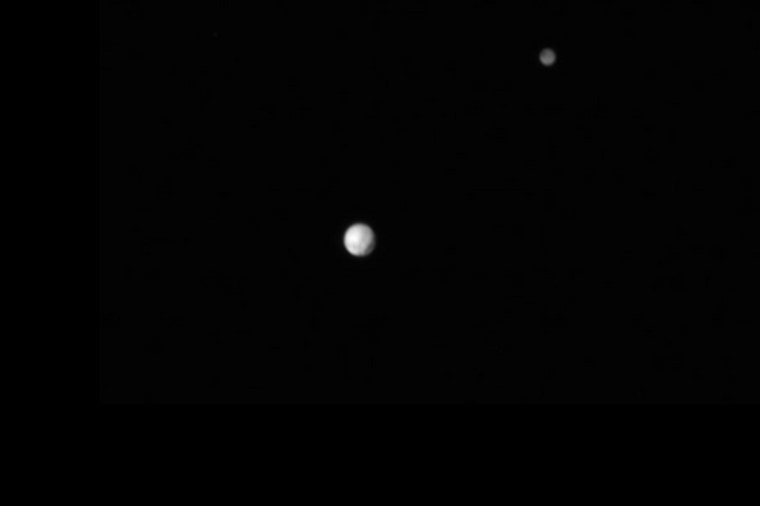Pluto and its largest moon, Charon, posed for a solemn portrait taken by NASA's New Horizon's probe, which is only two weeks away from its close encounter with the dwarf planet.
The newest snapshot of Pluto and Charon shows two icy gray circles hovering in a pitch-black void. In previous images, the two objects often looked like highly pixelated smudges of color — barely distinguishable as spheres. But with New Horizons only about 10 million miles (16 million kilometers) away from Pluto and closing in fast, the view of these unexplored worlds is getting clearer every day.

"Looking at pictures on the website, you can see that Pluto and Charon are becoming more distinct in their surface features," Alice Bowman, the missions operations manager for New Horizons, said Tuesday in a mission update. "It's getting pretty exciting. And every day is bringing new features into light." [New Horizons' Pluto Imagery Will Amaze Us (Video)]
New Horizons launched in January 2006 and has spent the last nine-plus years making its way toward Pluto and the region of icy bodies beyond Neptune, known as the Kuiper Belt. The mission is due to provide the first detailed look at the surface of Pluto.
Related: 'Dark Pole' Spotted on Pluto's Biggest Moon
The new portrait of Pluto and Charon was taken by the Long Range Reconnaissance Imager (LORRI) instrument onboard New Horizons. These images are not only for scientific and aesthetic purposes, but also for navigational ones, according to a statement from the Johns Hopkins University Applied Physics Laboratory in Laurel, Maryland.
Bowman said it takes about 4.5 hours to send a signal from APL's mission control center to New Horizons, 3 billion miles (4.8 billion kilometers) away. As a result, team members have to tell the probe what to do long before the probe actually does it.
When the probe makes its close flyby of Pluto on July 14, the team will not be able to make any last-minute adjustments. Instead, New Horizons will run pre-written command sequences.
The command sequences must also indicate where Pluto is located relative to the probe, and thus where New Horizons should point its instruments. The New Horizons team has been constantly updating that navigational information as the probe moves closer and can obtain more precise information about Pluto's location.
Earlier this month, the team executed a course correction to make sure the spacecraft didn't arrive at its close encounter point too early — if that were to happen, the photos might show nothing but empty space. In the next few days, Bowman said, the New Horizons team will be uploading the command sequence that will guide the probe through its historic flyby. There's also a possibility that the team will execute yet another course correction, she said.
Follow Calla Cofield @callacofield. Follow us @Spacedotcom, Facebook and Google+. Original article on Space.com.